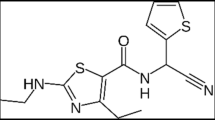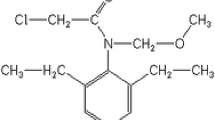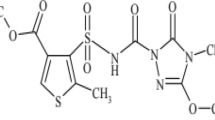Abstract
An intricate pesticide study is essential to assess its interaction with soil and environment. Fungicide Zoxamide has been examined for adsorption–desorption and degradation behaviour. Adsorption and desorption behaviour of Zoxamide on soil samples from geographically different regions of Pakistan utilizing batch equilibrium method was assessed. Degradation of Zoxamide was performed by hydrolysis, soil degradation and photodegradation. Degradation samples were extracted with dichloromethane and analysed at regular time intervals. The adsorption distribution coefficient values ranged from 0.9303 to 45.7 µg/mL with R2 value lying from 0.84–1. The variable sorption values can be associated with the diverse physicochemical properties. ∆G ranged from – 9.3 to – 11.39 kJ/mol, which indicates weak Van der Waal forces for interaction. Linear and Freundlich models were used for calculating sorption rate of the fungicide. The desorption values increased in following order: S2 < S9 < S6 < S5 < S7 < S3 < S4 < S2 < S8 < S1 < S10. The highest percentage of degradation was observed through hydrolysis (99.7%) and photodegradation (99%). Activated carbon prepared from Punica granatum peel was used for the removal of Zoxamide from soils for environmental remediation. Concentration-dependent studies displayed the concentration of 7.5 mg/L showed highest removal percentage of 96%. Zoxamide displayed an overall varying fate in the environment, which can be attributable to the type and geological nature of soils.








Similar content being viewed by others
References
Ahmad KS (2018) Exploring the potential of Juglans regia-derived activated carbon for the removal of adsorbed fungicide Ethaboxam from soils. Environ Monitor Assess 190:737
Arora S, Arora S, Sahni D, Sehgal M, Srivastava DS, Singh A (2019) Pesticides use and its effect on soil bacteria and fungal populations, microbial biomass carbon and enzymatic activity. Curr Sci 116:643–649
Baker BP, Green TA, Loker AJ (2020) Biological control and integrated pest management in organic and conventional systems. Biol Control 140:104095
Bhatnagar A, Minocha AK (2009) Adsorptive removal of 2, 4-dichlorophenol from water utilizing Punica granatum peel waste and stabilization with cement. J Hazard Mater 168:1111–1117
Cao Q, Huang Z, Liu S, Wu Y (2019) Potential of Punica granatum biochar to adsorb Cu (II) in soil. Sci Rep 9:1–13
Chiari M, Cortinovis C, Vitale N, Zanoni M, Faggionato E, Biancardi A, Caloni F (2017) Pesticide incidence in poisoned baits: a 10-year report. Sci Total Environ 601:285–292
Das A, Jaswal V, Yogalakshmi KN (2020) Degradation of chlorpyrifos in soil using laccase immobilized iron oxide nanoparticles and their competent role in deterring the mobility of chlorpyrifos. Chemosphere 246:125676
Debenest T, Silvestre J, Coste M, Pinelli E (2010) Effects of pesticides on freshwater diatoms. In: Reviews of environmental contamination and toxicology. Springer New York, pp 87–103
Egbe CC, Oyetibo GO, Ilori MO (2021) Ecological impact of organochlorine pesticides consortium on autochthonous microbial community in agricultural soil. Ecotoxicol Environ Safety 207:111319
Gul MM, Ahmad KS (2018) Chlorsulfuron degradation through bio-augmentation of soils by fungal strains and chemical hydrolysis. J Environ Chem Eng 6:955–963
Gul MM, Ahmad KS (2020) Assessment of methyl 2-({[(4, 6-dimethoxypyrimidin-2-yl) carbamoyl] sulfamoyl} methyl) benzoate through biotic and abiotic degradation modes. Open Chem 18:314–324
Hussain S, Siddique T, Saleem M, Arshad M, Khalid A (2009) Impact of pesticides on soil microbial diversity, enzymes, and biochemical reactions. Adv Agron 102:159–200
Iftikhar S, Ahmad KS, Gul MM (2018) Low-cost and environmental-friendly Triticum aestivum-derived biochar for improving plant growth and soil fertility. Comm Soil Sci Plant Anal 49:2814–2827
Kanmani P, Aravind J, Kamaraj M, Sureshbabu P, Karthikeyan SS (2017) Environmental applications of chitosan and cellulosic biopolymers: a comprehensive outlook. Bioresour Technol 242:295–303
Liang Q, Liu Y, Chen M, Ma L, Yang B, Li L, Liu Q (2020) Optimized preparation of activated carbon from coconut shell and municipal sludge. Mat Chem Phys 241:122327
Malandrakis A, Markoglou A, Ziogas B (2011) Molecular characterization of benzimidazole-resistant B. cinerea field isolates with reduced or enhanced sensitivity to zoxamide and diethofencarb. Pestic Biochem Phys 99(1):118–124
Michalkova A, Robinson TL, Leszczynski J (2011) Adsorption of thymine and uracil on 1: 1 clay mineral surfaces: comprehensive ab initio study on influence of sodium cation and water. Phys Chem Chem Phys 13:S7862-7881
Naeem H, Ahmad KS (2019) Gul MM (2020) Agrochemical 2-chloro-2’, 6’-diethyl-N-methoxymethylacetanilide tranformative and sorptive demeanor in agriculturally significant pedospheric environs. Int J Environ Anal Chem 10(1080/03067319):1700965
Neuwirthová N, Trojan M, Svobodová M, Vašíčková J, Šimek Z, Hofman J, Bielská L (2019) Pesticide residues remaining in soils from previous growing season (s)-Can they accumulate in non-target organisms and contaminate the food web? Sci Total Environ 646:1056–1062
OECD Guidelines for the Testing of Chemicals: Test No. 106 Adsorption Desorption Using a Batch Equilibrium Method (2000) Organization for Economic Cooperation and Development: Paris, France
Pan-Germany (2012) Pesticide and health hazards. Facts and figures, 1–16
Peña A, Gálvez A, Rodríguez-Liébana JA, de Cisneros CJ, Galindo AL, Viseras C, Caballero E (2017) Adsorption of nutrients on natural Spanish clays for enriching seed coatings. Adsorption 23:821–829
Rekanović E, Potočnik I, Milijašević-Marčić S, Stepanović M, Todorović B, Mihajlović M (2012) Toxicity of metalaxyl, azoxystrobin, dimethomorph, cymoxanil, zoxamide and mancozeb to Phytophthora infestans isolates from Serbia. J Environ Sci Health B 47:403–409
Salleh ZNM (2010) To produce the activated carbon from matured palm kernel shell. Doctoral dissertation, UMP
Santhi T, Manonmani S, Smitha T (2010) Kinetics and isotherm studies on cationic dyes adsorption onto Annona squmosa seed activated carbon. Int J Eng Sci Technol 2:287–295
Senthilkumar T, Raghuraman R, Miranda LR (2013) Parameter optimization of activated carbon production from Agave sisalana and Punica granatum peel: adsorbents for CI reactive orange 4 removal from aqueous solution. Clean: Soil, Air, Water 41:797–807
Senthilkumar T, Chattopadhyay SK, Miranda LR (2017) Optimization of activated carbon preparation from pomegranate peel (Punica granatum peel) using RSM. Chem Eng Comm 204:238–248
Shariff MR (2012) Effect of co-pesticide on adsorption-desorption process on agricultural soils. IJERD 1:55–69
Silva V, Mol HG, Zomer P, Tienstra M, Ritsema CJ, Geissen V (2019) Pesticide residues in European agricultural soils–a hidden reality unfolded. Sci Total Environ 653:1532–1545
Sofo A, Scopa A, Dumontet S, Mazzatura A, Pasquale V (2012) Toxic effects of four sulphonylureas herbicides on soil microbial biomass. J Environ Sci Health B 47:653–659
Tien CJ, Chen CS (2012) Assessing the toxicity of organophosphorous pesticides to indigenous algae with implication for their ecotoxicological impact to aquatic ecosystems. J Environ Sci Health 47:901–912
Venckatesh R, Amudha T, Sivaraj R, Chandramohan M, Jambulingam M (2010) Kinetics and equilibrium studies of adsorption of Direct Red-28 onto Punica granatum carbon. Int J Eng Sci Technol 2:2040–2050
WHO (1996) Permissible limits of heavy metals in soil and plants. Geneva: World Health Organization, Switzerland
Xu Z, Tian D, Sun Z, Zhang D, Zhou Y, Chen W, Deng H (2019) Highly porous activated carbon synthesized by pyrolysis of polyester fabric wastes with different iron salts: pore development and adsorption behavior. Coll Surf A Physicochem Eng Aspects 565:180–187
Zhang Y, Li W, Zhou W, Jia H, Li B (2020) Adsorption-desorption characteristics of pyraclonil in eight agricultural soils. J Soil Sed 20:1404–1412
Acknowledgements
The authors acknowledge the Department of Environmental Science, Fatima Jinnah Women University, Pakistan, for providence of technical facilities.
Author information
Authors and Affiliations
Corresponding author
Ethics declarations
Conflict of interest
Authors declare no potential conflict of interest.
Additional information
Publisher's Note
Springer Nature remains neutral with regard to jurisdictional claims in published maps and institutional affiliations.
Rights and permissions
About this article
Cite this article
Sajid, A., Ahmad, K.S., Gul, M.M. et al. Environmental toxicant Zoxamide sorption, degradation and Punica granatum-based activated carbon-mediated removal from soils. Environ Earth Sci 80, 412 (2021). https://doi.org/10.1007/s12665-021-09712-5
Received:
Accepted:
Published:
DOI: https://doi.org/10.1007/s12665-021-09712-5




